|
| |
| |
| |
Catalogue of acquisitions: paintings and drawings
July 1994 - December 1996
This catalogue contains all paintings and drawings purchased for the Van Gogh Museum from July 1994 to December 1996. Each work has an inventory number made up as follows: the first letter stands for the technique (s=painting, d=drawing); this is followed by a reference number and then by a capital letter (B=loan, N=State of the Netherlands, S=Van Gogh Museum [after 1 July 1994], SM=Van Gogh Museum [for the Museum Mesdag], V=Vincent van Gogh Foundation) and the year of acquisition.
A selection of works on loan to the museum in 1996 has been included here. A separate list of allloans now forming part of the collection can be found on pp. 253-59.
| |
Paintings
Alma-Tadema, Lawrence
Dutch, 1836-1912
Exhausted maenads after the dance
c. 1875
Oil on canvas, 59.1 × 132 cm
s 458 S/1996 (colour pl. p. 183)
Alma-Tadema's fame rests on his scenes of Roman and Greek antiquity, with which he captured the hearts of the prosperous middle classes in Victorian England. The bacchanal was one of his favourite subjects, but he always managed to keep the suggestion of debauchery within the accepted bounds of decency. The painting shows three inebriated maenads, as the followers of the wine god Dionysus were called, overcome by sleep. They are recognisable by their attributes: a silver wine goblet has rolled across the floor, at top left there is a cymbal, and in the foreground a staff of Bacchus. The scene is taken from Plutarch's Moralia, which relates how female devotees of Dionysus from Phocis strayed by mistake into nearby Amphissa after a night of revelry. They were on enemy territory, for the city was allied to Thebes, which was at war with Phocis. The revellers collapsed on the steps of the temple, where they were discovered by the women of Amphissa. The latter, worried about the reactions of their menfolk, took the maenads under their protection. The female bacchants were allowed to sleep off their debauch and were then helped on their way to the safety of their own territory. It is not entirely clear why the canvas, which Swanson dates 1873-74, was left unfinished. Perhaps the artist found the foreshortening of the woman on the left too difficult. What is more likely is that Tadema's patron, the art dealer Ernest Gambart, felt that the depiction of the three naked, entwined women was not exactly suitable for his public. It is certainly significant that Alma-Tadema restricted himself to just the woman in the foreground in a second, finished version of the subject. That painting, After the danceof circa 1876 is virtually the same size as the Exhausted maenads.The canvas remained in Alma-Tadema's studio, and in 1883 he gave it to his friend Caret Vosmaer (1826-1888), the writer and man of letters. The latter hung it
over his bookcase, as can be seen in a photograph of his study, and even made a small, clumsy sketch of it. (See also the article by J.F. Heijbroek in this volume of the Van Gogh Museum Journal.)
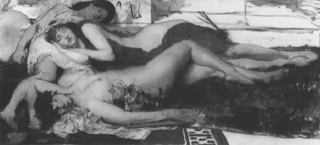
| |
| |
Provenance Carel Vosmaer (1883-1888); heirs of Vosmaer; Christie's (London), 24 November 1989, lot 80; Hazlitt, Gooden & Fox, London; purchased by the Van Gogh Museum with support from the Vereniging Rembrandt, with the help of the Prins Bernhard Fonds (1996).
Literature F.L. Bastet et al., De verzameling van mr. Carel Vosmaer (1826-1888), The Hague 1989, pp. 141-42; Vern G. Swanson, The biography and catalogue raisonné of the paintings of Sir Lawrence Alma-Tadema, London 1990, p. 173, no. 162; Edwin Becker and Louis van Tilborgh, ‘Uitgeputte maenaden na de dans,’ Vereniging Rembrandt: Nationaal Fonds Kunstbehoud6 (1996), no. 1, pp. 13-16; Edwin Becker, et al. (eds.), exhib. cat. Sir Lawrence Alma-Tadema, 1836-1912, Amsterdam (Van Gogh Museum) & Liverpool (Walker Art Gallery) 1996, no. 34.
Our corner: portrait of Anna and Laurense Alma-Tadema 1873
Oil on canvas, 56.4 × 47.8 cm
Signed, dated and inscribed at upper right:
L. Alma-Tadema1873, Op. CXVI
s 454 S/1995 (colour pl. p. 182)
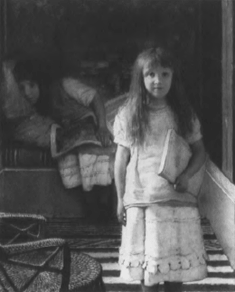
Alma-Tadema's work is rightly associated with subjects from classical antiquity, but another side of his art is demonstrated in this lovingly painted portrait of 1873 of his daughters Anna and Laurense, in which he also illustrated their hobbies. The six-year-old Laurense, who stands as stiff as a ramrod in the foreground, is holding some sheet music, and probably played the piano. Her sister Anna, two years her junior, who appears to have withdrawn to the sofa in a sulk, had not progressed that far: she was fond of picture books. The artist painted his children in a corner of Townshend House, which he had bought in 1871. ‘Our corner’ was the fitting title given to the work when it went on display in the Dudley Gallery two years later. Alma-Tadema gave the work an opus number, CXVI, and as usual had it photographed. The engraving that his friend Leopold Löwenstam made from the photograph was published in the Art Journalin 1878, together with a somewhat disdainful commentary on the painter's effort: ‘The picture in its entirety can only be accepted as an example of this clever artist's idiosyncrasies; it may, however, be remarked that it is painted with his acknowledged attention to detail.’
It is known from a letter to the writer Carel Vosmaer that the artist intended the portrait as a present for his wife Laura Epps. Her own studio (she was also a painter) was furnished in the 17th-century Dutch style, and it was evidently for that reason that the picture was given a black, wooden frame. Anna and Laurense were the children of Alma-Tadema's first marriage; Laura Epps was their stepmother. Interestingly, that same year Laura's sister Ellen also made a portrait of the two children which is now in the Museum Mesdag in The Hague. Tadema's daughters inherited the portrait on their stepmother's death in 1909. Laurense died in 1940, Anna three years later. (See also the article by Hanna Pennock in this volume of the Van Gogh Museum Journal.)
Provenance Laura Alma-Tadema Epps (1873-1909); Anna and Laurence Alma-Tadema, London; C.M. Dyson-Perrins; Sotheby's (London), 22 April 1959, lot 70; Miss Katherine Lewis; Mrs Elizabeth Wansbrough, Lechlade (until 1995); Peter Nahum, London; purchased by the Van Gogh Museum (1996).
Literature Vern G. Swanson, The biography and catalogue raisonné of the paintings of Sir Lawrence Alma-Tadema, London 1990, pp. 171, 344, no. 156; Edwin Becker and Louis van Tilborgh, ‘Lawrence Alma-Tadema en zijn dochters,’ Antiek31 (1996), pp. 40-41; Van Gogh Bulletin 11 (1996), no. 2, pp. 12-13; Edwin Becker, et al. (eds.), exhib. cat. Sir Lawrence Alma-Tadema, 1836-1912, Amsterdam (Van Gogh Museum) & Liverpool (Walker Art Gallery) 1996, no. 31.
Hadrian visiting a Romano-British pottery 1884
Oil on canvas, 159 × 171 cm
Signed and inscribed at lower right:
L. Alma-Tadema Op. CCLXI B
s 137 B/1996
This painting was originally part of a large work depicting Hadrian in England: visiting a Romano-British, pottery, exhibited at the Royal Academy in 1884; the artist later cut the picture into three pieces, one of which is the canvas on loan to the Van Gogh Museum. As in The sculpture galleryand The picture gallery, Alma-Tadema has here concentrated on the commercial aspect of art production in the ancient world. The direct inspiration for the work was probably Georg Eber's novel The emperor, published in 1881, which placed particular emphasis on Hadrian's support for local industries in the provinces. The emperor visited Britain in 121 of
| |
| |
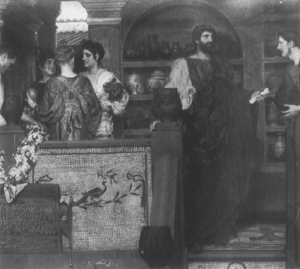
A.D., and it is presumably an - albeit invented - episode from that trip that Alma-Tadema has depicted. The scene shows the emperor conversing earnestly with the workshop's proprietor, while his female companions inspect the items for sale. As in Eber's novel, he is characterised as genuinely interested in the well-being of his subjects, appearing almost in the guise of a fatherly philosopher or orator. The true meaning of the work, however, is indicated in the inscription just to the left of the staircase: Salve Lucri or ‘Hail to gain.’
Provenance Oldenzeel gallery, Rotterdam (1886); H. Koekkoek Jr, London and Amsterdam (until 1894); M.P. Langhuizen, Hilversum and Craailo; Amsterdam (Frederik Muller), 29 October 1918, lot 101; Vereeniging tot het Vormen van een Openbare Verzameling van Hedendaagse Kunst, Amsterdam; donated to the Stedelijk Museum, Amsterdam (1949); on loan to the Van Gogh Museum (1996).
Literature Henry Blackburn, Academy notes 1884, London 1884, p. 20; Carel Vosmaer, ‘Een schilderij van Alma Tadema,’ De Nederlandsche Spectator (4 September 1886), pp. 294-96; G. Marius, ‘Een praatje over schilderijen,’ De Nederlandsche Spectator (9 December 1893), pp. 396-97; Jan Veth, Hollandsche teekenaars van deze tijd, Amsterdam 1905, pp. 4-5; Vern G. Swanson, The biography and catalogue raisonné of the paintings of Sir Lawrence Alma-Tadema, London 1990, no. 297; Richard Bionda and Carel Blotkamp (ed.), De schilders van Tachtig: Nederlandse schilderkunst 1880-1895, Zwolle 1991, pp. 114-15; Edwin Becker, et al. (eds.), exhib. cat. Sir Lawrence Alma-Tadema, 1836-1912, Amsterdam (Van Gogh Museum) & Liverpool (Walker Art Gallery) 1996, no. 64.
| |
Boulanger Gustave-Rudolphe
French, 1824-1888
Phryne 1850
Oil on canvas, 140 × 106 cm
Signed and dated at lower left: GUSTAVE. RODOLPHE. BOULANCER./ROMA (A) MDCCCL;
inscribed centre left (on cushion): ɸRYNH.
s 456 S/1996 (colour pl. p. 177)
The orientalising beauty regarding us provocatively from her couch is identified by an inscription on the left of one of the richly-upholstered cushions: she is the classical courtesan Phryne. She owed her fame to the fact that, as the sweetheart of the celebrated Greek sculptor Praxiteles, she was the model for one of the most renowned sculptures of Antiquity, the Aphrodite of Knidos.
As a pupil of Paul Delaroche, Gustave Boulanger was part of a group of young artists with a passion for archaeologically-correct reconstructions of classical scenes, which earned them the title néo-grecs. Like his colleague Jean-Léon Gérôme, Boulanger combined an interest in antiquity with a great love of the Orient. In 1845 he had spent eight months working in Algeria, and in 1848 he made his debut at the Paris Salon with Indians playing with panthers and A moorish café. In the following year he rounded off his studies by winning the Grand Prix de Rome with his painting Ulysses recognized by Euryclea (Paris, Ecole nationale supérieure des Beaux-Arts), a virtuoso work in néo-grec style which the prominent critic E.J. Delécluze described as ‘something asiatic, oriental and quite peculiar.’ Boulanger arrived in Rome in 1850. That same year, as a proof of his ability, he sent his Phryne to Paris. His was hardly a conventional theme at this time, although, quite by coincidence, the name of Phryne also featured in Charles Baudelaire's contemporaneous poem ‘Lesbos.’ The canvas met with a cool reception at the Institut. The professors accused Boulanger of having ‘neglected to too great a degree the natural and the simple’; he was advised to learn from ‘the great examples of true grace that Italy offered to his eyes [...].’ He seems, however, to have had little interest in the ‘natural and the simple,’
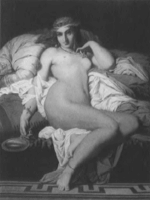
| |
| |
for his figures continued to display a considerable eccentricity. Delécluze felt that Boulanger's work represented ‘an elegance that was more contrived than natural,’ and that his figures were sometimes ‘rather too colossal.’
While the theme had occurred sporadically throughout the 17th and 18th centuries, the only significant 19th-century precursor of Boulanger's work was the Phryne executed by the sculptor James Pradier in 1845, which is known in a number of variants. An unfinished canvas painted by Charles Gleyre in 1858-59 was based on Pradier's figure; Gleyre abandoned this work when he heard that Gérôme was engaged in a painting on the same theme. The latter's Phryne before the judges (Hamburger Kunsthalle), which was presented at the Salon of 1861, was to remain among the most famous depictions of Phryne.
Provenance Galerie Elstir, Paris; purchased by the Van Gogh Museum (1996).
Literature J. Heusinger von Waldegg, ‘Jean-Léon Gérômes “Phryne vor den Richtren,”’ Jahrbuch der Hamburger Kunstsammlungen (1972), no. 17,

pp. 122-42; M.-M. Aubrun, ‘Gustave Boulanger, “peintre éclectique,”’ Bulletin de la Société de l'Histoire de l'Art français [1986] (1988), pp. 167-256; Van Gogh Bulletin 11 (1996), no. 3, pp. 10-13.
| |
Bremmer, Rudolf
Dutch, 1900-1993
Portrait of Hendricus Petrus Bremmer
c. 1955
Oil on canvas, 55.4 × 45.1 cm
s 446 N/1995
This portrait of Hendricus Petrus Bremmer (1871-1956) by the subject's son Rudolf shows the painter and celebrated art teacher at a very advanced age. The work is neither signed nor dated, but the deeply-lined face bears a great resemblance to a drawing of Bremmer that was also made by his son and is dated 1955. The painting was probably executed around that time, and thus shows Bremmer at approximately the age of 84.
H.P. Bremmer started teaching art appreciation in 1893. His students were drawn mainly from wealthy backgrounds; some were already collectors, while, under Bremmer's tutelage, others developed a taste for this activity. In this way Bremmer placed a particular stamp on a whole generation of private collections in Holland. Patrons such as Ribbius Peletier and Van Baaren received much guidance from him, but his most memorable influence was on the collection of Hélène Kröller-Müller, which now constitutes the core of the works assembled in the eponymous museum.
Vincent van Gogh occupied an important - perhaps predominant - position in the pantheon of modern artists that Bremmer presented to his students. Bremmer had a great fondness for Vincent's work, which he himself collected. In 1911 he published his Vincent van Gogh: inleidende beschouwingen, the first monograph devoted to the artist.
Provenance Kunsthandel Monet, Amsterdam; purchased by the Van Gogh Research Foundation; donated to the State of the Netherlands for placing in the Van Gogh Museum (1995).
| |
Chintreuil, Antoine
French, 1816-1873
The ruins of the castle of Mont Chauvet
Oil on canvas, 40 × 64 cm
Signed at lower right: Chintreuil
s 459 S/1996
Although the landscape painter Chintreuil is considered one of Corot's most remarkable pupils, he was in fact largely an autodidact. He made his Salon debut in 1847 and in 1867 he was finally awarded a medal there. His poor health and uncompromising sincerity meant that he had lifelong difficulty in supporting himself by painting. According to his biographer La Fizelière, he possessed ‘the intuition of the mysterious language of nature’ to a remarkable degree. Odilon Redon praised the painter for his ‘severe and chaste’ art, whose ‘discreet form and deep, passionate reserves find an echo only in a few elect souls.’
As with Corot, Chintreuil's strength lay primarily in his depictions of nature in misty morning moods or on hazy autumnal days. He also excelled at capturing the infinite varieties of fresh greenness in springtime landscapes. Here, for example, the
| |
| |
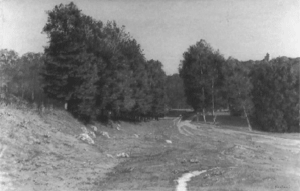
gently undulating woodland provided the painter with an ideal pretext for a virtuosic display of innumerable nuances of green. Glimpsed with some difficulty in the distance beyond the treetops is the castle of Mont Chauvet, which gives the canvas its title. When Chintreuil died in 1873, the painting was in the possession of his colleague Charles Daubigny, whom he had befriended in 1850.
Provenance Charles Daubigny (1874); Collection Brame, Paris; G. Père, Paris; Galerie Berne-Bellecour, Paris (1893-96); A. Ray, Marseilles (1896); Stoppenbach & Delestre Ltd, London; purchased by the Van Gogh Museum (1996).
Literature A. de La Fizelière, et al., La vie et l'oeuvre de Chintreuil, Paris 1874, no. 279.
| |
Courbet, Gustave
French, 1819-1877
‘La Méditerranée’: view of the Mediterranean at Maguelonne, near Montpellier 1858
Oil on canvas, 92 × 135 cm
Signed at lower right: G. Courbet./58
s 455 V/1996 (colour pl. p. 181 )
This painting is one of the artist's earliest marines. It is immediately striking for its total absence of human activity: there are no figures, no ships on the horizon. The beautifully-painted sky accounts for two thirds of the total surface. Water and rocks are the only other elements on the canvas, whose facture is also striking: the whole painting has been executed with the palette knife.
In 1854, on the invitation of Alfred Bruyas, Courbet travelled to the Mediterranean for the first time. He stayed with Bruyas in Montpellier for three months. In essence, the two small canvases of the Mediterranean near Palavas that he painted during this visit (Fernier numbers 152 and 153) were heralds of the compositional elements present in the museum's recent acquisition. Although the ships visible on the horizon have been excluded in this later work, there is the same vast expanse of sea with rocks at the foreground right.
Courbet repeated his visit to Montpellier in 1857 and 1858. In a letter dated 23 June 1857 he wrote to Armand Gautier that he had produced three marine sketches. He announced his intention of ‘painting two serious works of a metre 1/2 in

length’; this would appear to be a reference to this work and to a nearly identical, similarly-sized version that is now in the museum at Sankt Gallen ( La Mer aux rochers). Both of these works are dated 1858.
Although the present work does not feature in Fernier's oeuvre catalogue, some details concerning its provenance are mistakenly included under his no. 238, the Sankt Gallen painting. Since that time, however, Mr Jaap Brouwer has convincingly unravelled the data relating to the provenance of the two works (see provenance below). Another work akin to these two paintings is a slightly smaller canvas (Fernier no. 610) in the Pushkin Museum, executed in 1867.
It was suggested (on Fernier's authority) in Pierre Courthion's L'opera completa di Courbet, Milan 1985 (p. 86) that the Van Gogh Museum's work was shown at the Courbet exhibition in 1867. The painting's provenance from the Cantin collection, however, speaks against this assumption.
The presence on the frame of a label from the firm of Sala suggests that the current frame was supplied by this well-known Dutch firm.
Provenance In 1867, no. 44 at the ‘Exposition des oeuvres de M.G. Courbet’ at the Rond-Point du Pont de l'Alma as ‘Vue de la Méditerranée, à Maguelonne, près Montpellier (Hérault, 1858)’ belonging to the Cantin collection; sale Cantin collection, Paris (Hôtel Drouôt), 19 April 1895, lot 20 (as ‘Marine’); Gérard, Brussels; Fritz Meyer, Zürich; Joh. Koch; E. van Essen; on loan to the Stedelijk Museum, Amsterdam (1915-22); sale Van Essen collection, Amsterdam (Frederik Muller, assisted by E.J. van Wisselingh), 8 May 1923, lot 22; private collection, the Netherlands; purchased by the Vincent van Gogh Foundation (1996).
Literature Exhib. cat. Schilderijen en aquarellen [...] Vereeniging tot het vormen van eene openbare verzameling van hedendaagsche kunst, Amsterdam (Stedelijk Museum) 1910, no. 83; exhib. cat. Van Daumier tot Picasso: Twents particulier bezit, Almelo (Museum De Waag) 1956, no. 24; R. Fernier, La vie et l'oeuvre de Gustave Courbet: catalogue raisonné, Lausanne 1978, nos. 238 and 610 (for the versions in the Sankt Gallen Museum and the Pushkin Museum, Moscow); Van Gogh Bulletin 11 (1996), no. 2, pp. 10-11.
| |
| |
| |
Decamps, Alexandre-Gabriel
French, 1803-1860
A Turkish school 1846
Oil on canvas, 117 × 94 cm
Signed and dated at lower right: DECAMPS 46
s 156 B/1996
Thanks partly to a long-term loan from the Amsterdams Historisch Museum, the Van Gogh Museum is now able to show a small but exquisite group of orientalist paintings. Their interest is enhanced by the fact that these were among the first Dutch acquisitions of works of their type. In the years around 1860 approximately fifteen paintings by Decamps had owners in Amsterdam. The work illustrated here came from the collection of the Amsterdam merchant Carel Joseph Fodor (1801-1860).
Provenance Sale Thévenin collection, Paris (Hôtel des Ventes Mobilières), 27 January 1851, lot no. 22; C.J. Fodor; Fodor Bequest to the City of Amsterdam (1860); Amsterdams Historisch Museum; on loan to the Van Gogh Museum (1996).
Literature Exhib. cat. Levende Meester: De schilderijenverzameling van C.J. Fodor 1801-1860, Amsterdam (Amsterdams Historisch Museum) 1995, no. 34 and pp. 100-01 (with extensive bibliography); Ronald de Leeuw, De collectie Europa: Het verzamelen van buitenlandse kunst in Nederland, Amsterdam & Zwolle 1995, p. 34.
| |
Gérôme, Jean-Léon
French, 1824-1904
Golgotha (‘Consumatum est’) c. 1868
Oil on canvas, 63.5 × 98 cm
Signed at lower left: J.L. GEROME
s 453 S/1995 (colour pl. p. 179)
This painting is a reduced replica of Gérôme's submission to the Salon of 1868 (no. 1072), which was acquired in 1990 by the Musée d'Orsay. This smaller version was painted for the purposes of a later lithograph; although they are now concealed by the frame, this can be seen from the broad ochre borders along the top and bottom edges of the canvas. The quality of the replica is extremely high and the differences between the two versions very small, the most striking being the signature, which is arched in the larger version, and straight in the reduction. The work is known under a variety of names, including Consumatum est, Jerusalem and The crucifixion. The artist himself, however, seems to have preferred the title Golgotha. When Gerald Ackerman's 1986 Gérôme oeuvre catalogue was published, the replica was still unknown. This is the reason that the provenance of the Salon version in the Musée d'Orsay was confused with that of the replica.
The painting shows a panoramic view seen from a bare mountain; in the distance are Jerusalem and its temples under a torrent of rain. A procession of Roman soldiers winds its way from the mountain towards the city gate. Two soldiers look back at the three long shadows cast on the rocks by the crosses of Jesus and the two thieves. With a nearly surrealistic inventiveness, Gérôme's refined composition evinces effects whose causes are unspecified or unpainted. Partly because of the great topographical precision of the view of Jerusalem, the canvas can be regarded as an attempt to depict the story of Jesus's suffering as an historical event, here strictly and scientificly reconstructed, rather than as an element of dogma. Gérôme had visited the holy city in April 1862, where devoted close study not only to the architecture but also to the weather: there was, he noted, ‘incessant rain’ and a ‘violent wind.’
Gérôme's innovative interpretation was vigorously attacked by elements of the press. Théophile Gautier described Golgotha as ‘more picturesque than religious,’ but he praised Gérôme's ‘striking power of invention.’ However critical the press may have been, the popularity of the work is demonstrated by the sheer number of times it was reproduced. And in his Salon critique, Thoré-Bürger wrote: ‘Such is the subtle invention of M. Gérôme,

| |
| |
assuredly a very artistic caprice, that it might have inspired Goya to a lively aquatint or Daumier to a lithograph.’ In 1871 Goupil published a large etching by Herman Eichens that took the Amsterdam replica as its model. The replica was also the basis for the folio photogravure bound into Fanny Hering's Gérôme (New York 1892). Finally, during the 19th century in the Netherlands, Joh. de Liefde of Utrecht published a lithograph after the work, with a pendant print of Judas's betrayal in the Garden of Gethsemane (examples at The Hague, Rijksdienst Beeldende Kunst, inv. nos. AA 428 and 429). [With thanks to Gerald M. Ackerman and Jan de Hond.]
Provenance Dowager W.J. Royaards van den Ham, Utrecht; Amsterdann (Frederik Muller), 8 November 1910, lot 27; private collection. The Netherlands; Pieter Hoogendijk, Baarn; purchased by the Van Gogh Museum (1995).
Literature Fanny Hering, Gérôme, New York 1892, p. 204 (ill.); exhib. cat. Gérôme, Vesoul (Musée de Vesoul) 1981, no. 207; Gerald M. Ackermann, The life and work of Jean-Léon Gérôme, New York 1986, no. 169 (Salon version); Ronald de Leeuw, De collectie Europa: Het verzamelen van buitenlandse kunst in Nederland, Amsterdam & Zwolle 1995 p. 42-43; Gazette des Beaux-Arts 138 (March 1996), p. 93; for bibliography on the Salon version in the Musée d'Orsay see De Manet à Matisse. Sept ans d'enrichissements, Musée d'Orsay, Paris 1990, p. 61.
| |
Gogh, Vincent van
Dutch, 1853-1890
Peasant woman digging potatoes 1885
Oil on canvas on panel, 42 × 32.5 cm
s 452 S/1995 (colour pl. p. 189)
Peasant woman digging potatoes is typical of the figure studies that Van Gogh produced during his stay in Nuenen (1884-85). He wanted to record the traditional, unsullied existence led by the local rural population at the time. During his first year in Nuenen he concentrated on scenes of weaving, the typical cottage industry of Brabant, but in the following year he focused almost entirely on work on the land. To economise as much as possible, he portrayed the workers mainly in drawings, and only on a few occasions did he give in to the temptation to depict his motifs in the much more expensive medium of oils - although even then he still opted for a small format. In his correspondence he only mentioned these small studies in passing. ‘I have mainly been working in quite a small format recently’ [529/R57] he wrote at the end of August to his friend Anthon van Rappard. There are nine known paintings devoted to this theme, four of which show figures digging potatoes.
This particular scene was painted in the summer of 1885, but it is not known precisely when. The work of lifting potatoes probably began at the end of July or beginning of August and was finished by late September. The painting could not have been made in the latter month, though, because by then Van Gogh's supply of models had dried up. The local Catholic priest had put pressure on his parishioners to stop posing for the artist.
The painting is above all an exercise in form, not colour. After painting his Potato eaters that spring, Van Gogh realised that he was not modelling his figures convincingly. The torsos were too flat, he decided, and immediately set about correcting the error. Eventually he began achieving results, as this well-observed, gnarled figure shows. He also practised perspective, for a figure bending forwards is difficult to render convincingly. Here he was less successful, for the woman's torso is too small relative to the rest other body.
Provenance Oldenzeel gallery, Rotterdam (1904); Jan Smit, Alblasserdam; Amsterdam (Mak van Waay), 10 February 1919, lot 33; John James Enthoven, Voorburg; W. Brinkman, Schipluiden (1952-61); private collection (1962-94); bequeathed to the Van Gogh Museum (1995).
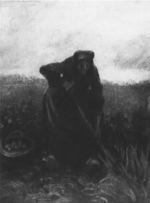

| |
Harpignies, Henri-Joseph
French, 1819-1916
View of the Chateau d'Hérisson 1871
Oil on canvas, 41.2 × 63.5 cm
Signed and dated at lower left: h.j. harpignies 1871;
inscribed at lower right: Hérisson
s 450 S/1995 (colour pl. p. 180)
Lost while a member of a hunting party on the family estate of one of his pupils in September 1869, Harpignies suddenly came upon the ruins of the fortress of Hérisson, to the south of Bourges. So great was his enchantment that it featured prominently in his correspondence until November of that year. He was subsequently to visit it each summer until 1878, accompanied by a group of students, the so-called ‘Hérisson School.’
The dilapidated castle stands right in the centre of this recently-acquired work. An inscription on the stretcher informs us that this view was painted ‘from the road to Bel-Air in May 1871.’ The clarity of the landscape is striking, with the silhouette of the ruins accentuated by Harpignies's subtle use of backlighting. The hazy atmosphere of the overgrown slopes is beautifully rendered; here and there, blue-grey smoke curls upwards from chimneys. Blue is used in remarkable abundance; on one of his journeys to Italy, Harpignies had already pronounced, ‘In nature, gentlemen, cobalt predominates.’
Provenance Sale Cronier collection, Paris (Georges Petit), 11-12 March 1908, lot 50; Arnold; London (Sotheby's), 5 July 1961, lot 185; Sir Ronald Pruin, Weybridge (Surrey); Hazlitt, Gooden & Fox, London; purchased by the Van Gogh Museum (1995).
Literature Van Gogh Bulletin 10 (1995), no. 3, pp. 10-11.
| |
| |
| |
Israëls, Isaac
Dutch, 1865-1934

Woman reading next to Van Gogh's ‘Sunflowers’
Oil on canvas, 60.6 × 40.6 cm
Signed at lower right; Isaac Israels
s 451 N/1995
In 1919, Isaac Israëls had a number of Van Gogh paintings on loan from Johanna van Gogh-Bonger: Sunflowers, The yellow house and The bedroom. The latter can be seen in an Israëls sketch at the Van Gogh Museum (d 736 V/1982). The Sunflowers (in both cases the version now hanging in the National Gallery in London) features in two paintings by Israëls at the Van Gogh Museum, one of which is this donation of 1995. Van Gogh's still life stands on a painter's easel. To the left, a woman sits reading a book. Somewhat remarkably, she is clad in a heavy coat and wears a hat.
Provenance Mrs Sonja B. Wertheimer-Weijl; bequeathed to the State of the Netherlands for placing in the Van Gogh Museum (1995).
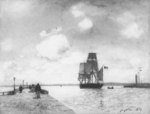
| |
Jongkind, Johan Barthold
Dutch, 1819-1891
The jetty at Honfleur 1865
Oil on canvas, 33.7 × 43.2 cm
Signed and dated at lower right: Jongkind 1865
s 460 V/1996 (colour pl. p. 184)
Jongkind occupies a place in art history alongside the precursors of Impressionism. In 1900, Claude Monet, who worked with him in the mid-1860s, wrote: ‘He amplified what I had already learned from Boudin, but from that moment it was Jongkind who was my real teacher. To him I owe the crucial training of my eye.’
The jetty at Honfleur projected far into the water, and was a popular vantage point from which to view the boats entering or leaving the harbour. This recently-acquired painting, La jetée à Honfleur, dates from Jongkind's last stay there, which took place at the end of August and during September 1865. It is one of the most powerful and compact compositions the artist ever made on this theme, and is closely allied to the etching The wooden jetty at Honfleur, which also dates from 1865. The existence of a painting similar in terms of composition (auctioned at Galerie Georges Petit, 3 March 1919, lot 31) gives rise to the assumption that both works were painted from the same preliminary study or watercolour.
In Le Figaro of 12 June 1864, Jongkind's friend Jean Rousseau described a similar view of Honfleur harbour as ‘a small miracle. For colouring there is nothing in this world that is finer or better judged, not even the delightful landscapes of Corot. Both painters share a sense of naivety; they have the same milky and pearl-like skies, the same frank and limpid light. Mr Jongkind, however, is a Corot à l'état sauvage.’
Provenance Probably Théophile Bascle, Bordeaux; Paris (Georges Petit), 12-14 April 1883, lot 83; sale collection M.C.V., Paris (Georges Petit), 27 May 1920, lot 48; C. Vignier, Paris; Jacques Dubourg, Paris; E.J. van Wisselingh and Co., Amsterdam; Laing Gallery, Toronto (1948); Mrs T.P. Lownsborough, Toronto (c. 1948-56); E.J. van Wisselingh and Co., Amsterdam (1956); private collection, Chicago (1957); New York (Christie's), 22 May 1996, lot 101; purchased by the Vincent van Gogh Foundation (1996).
Literature Exhib. cat. Connecticut collects, Hartford (Wadsworth Atheneum) 1957, no. 24, pl. 3; exhib. cat. Masterpieces from private collections in Chicago, Chicago (The Art Institute) 1969, no. 25; Victorine Hefting, Jongkind: sa vie, son oeuvre, son époque, Paris 1975, no. 339; exhib. cat. Jongkind and the Pre-impressionists: painters of the Ecole Saint-Siméon, Northampton, Mass. (Sterling and Francine Clark Art Institute) & Williamstown, Mass. (Smith College Museum of Art) 1976-77, no. 10.
| |
Marilhat, Prosper-Georges-Antoine
French, 1811-1847
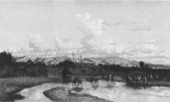
Landscape with caravan fording a river
Oil on panel, 34.5 × 62 cm
Signed at lower left: P. MARILHAT
s 158 B/1996
Marilhat died young, and in the Netherlands his work is scarce indeed. In the third quarter of the 19th century there was, in the collection of Van Walchren van Wadenoyen, another depiction of a caravan (Paris [Durand-Ruel & Petit], 24-25 April 1876, lot 52, with ill.); and recently a wooded landscape was auctioned (Amsterdam [Sotheby's], 16 April 1996, lot 118), that once belonged to the well-known De Kuyper collection.
Carel Joseph Fodor bought this painting shortly be- | |
| |
fore his death. It was much admired by the painter Gerard Bilders, who had special praise for the painting of the sky: ‘There is a sky above that landscape so brilliant, so sunny, so true, that is seems to me I have never previously seen its like in a painting.’ Earlier, in 1857, Fodor had purchased a drawing by Marilhat that also featured a caravan.
Provenance Sale Dubois collection, Paris (Hôtel Drouôt), 16 February 1860, lot 20; C.J. Fodor; Fodor Bequest to the City of Amsterdam (1860); Amsterdams Historisch Museum; on loan to the Van Gogh Museum (1996).
Literature Exhib. cat. Levende Meesters: De schilderijenverzameling van C.J. Fodor 1801-1860, Amsterdam (Amsterdams Historisch Museum) 1995, no. 88, pp. 78-79, 134.
| |
Mauve, Anton
Dutch, 1838-1888
Woodcutters
Oil on canvas, 111 × 160 cm
Signed at lower right: A. Mauve. f.
s 138 B/1996
Thanks to this loan from the Stedelijk Museum, the Van Gogh Museum is finally able to do proper justice to Van Gogh's cousin-by-marriage and only teacher. While our collection admittedly contains a few minor scribbles and Bleaching field, a watercolour acquired in 1980, this ambitious canvas now shows for the first time a full-size painting by Mauve. In addition, its subject is both typical of the artist and is one that Van Gogh himself tried on a number of occasions. Earlier in the century, in his painting Le Massacre des innocents (The Hague, Museum Mesdag), Théodore Rousseau had turned a realist depiction of woodcutters tearing down branches of big forest trees into an impressive protest against human interventions in nature. Mauve's treatment of the same subject seems to have had no such environmental connotations. Instead, he stressed the harmony of the working man with his surroundings, an approach that would later characterise his pupil Van Gogh. The Museum of Fine Arts in Boston possesses a fine Woodcutters in the forest in which the same motif is shown in close-up.
Provenance Stedelijk Museum, Amsterdam; on loan to the Van Gogh Museum (1996).
Literature D.C. Preyer, The art of the Netherland Galleries, London 1908, p. 291; A. Preyer, ‘Karakterschets op z'n Amerikaans,’ De Hollandsche Revue (1918), no. 23, p. 387; exhib. cat. Anton Mauve (1838-1888): in harmonie met de natuur, Wassenaar (Raadhuis de Pauw) 1991, no. 19.
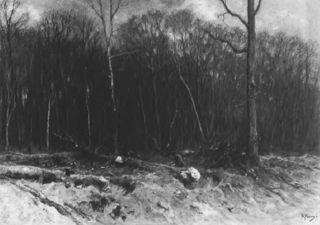
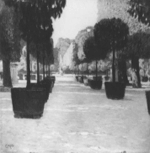
| |
Moll, Carl
Austrian, 1861-1945
Schönbrunn c. 1910
Oil on panel, 35.5 × 35.5 cm
Signed at lower left: C. Moll
s 448 S/1995 (colour pl. p. 192)
As a reaction to the ‘natural’ English style of gardening, the Vienna Secessionists discovered the beauties of austerely-designed Viennese gardens in the years around 1900. Proceeding from the rectilinear forms and the linear distribution of space in interior design, landscape gardeners returned to designs featuring tightly-clipped hedges, dividing walls and narrow avenues opening onto a vista. The small, square panel Schönbrunn, a sunny glimpse into the gardens of this Viennese palace, is a fine example of this interest in the gardens of the Baroque. With a touch influenced by Impressionism - airy yet pastose - and with many nuances of colour, Moll painted a neat row of orangerie trees flanking an avenue leading to a fountain. The soft pastel colours so characteristic of his palette, pink, grey-blue and pale green, contrast with the deep dark green of the trees. The shaded areas in the foreground, with the bright sunlight occasionally filtering through, are especially successful. Other features of Moll's work are its flatness and the careful balancing of the composition. His division of the canvas into horizontals and verticals was in accordance with the so-called Flächenstil, an ornamental style influenced by Japanese prints and applied art; it was characteristic of the group of Stylists within the Vienna Secession to which Moll belonged.
| |
| |
Provenance Kunst- und Antiquitätenhandel Sonja Reisch, Vienna; purchased by the Van Gogh Museum (1995).
Literature Hans Dichand, Carl Moll, Salzburg 1985, p. 65; Van Gogh Bulletin 10 (1995), no. 3, pp. 12-14.
| |
Monet, Claude
French, 1840-1926
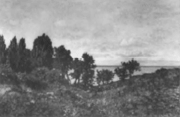
Coastal landscape c. 1864
Oil on canvas, 53.2 × 80.7 cm
Signed at lower right: C. Monet
s 461 S/1996 (colour pl. p. 185)
This lovely coastal landscape is an early work by Monet, from the period in which he began to develop the tonal art of the School of Barbizon in the direction of a lighter palette and looser brushwork. Although undated, Wildenstein's catalogue places it in 1864, namely among the two dozen earliest works known from the artist's hand. Here, the painter has still signed with ‘C. Monet,’ while pictures painted after 1865 generally bear his full signature. This work was probably painted in the vicinity of Honfleur, where Monet spent a considerable amount of time in the second half of the 1860s. In a certain sense, the emphasis on the vegetation unites the worlds of Barbizon, Boudin and Jongkind, so that we may presume a dating shortly after the artist's stay in Fontainebleau.
It was at Easter in 1863 that Monet and his friend Frédéric Bazille spent their vacation painting in Chailly for the first time, on the edge of the forest at Fontainebleau, two kilometres from Barbizon. This visit was repeated a year later, this time with Renoir and Sisley as well. The works by this group of young, like-minded painters bear a certain resemblance at this time. Moving on to Honfleur, they at first chose motifs allied to the forest landscape at Chailly. In a letter to his mother dated 1 June 1864, Bazille described how he and Monet had found the ideal surroundings for their art in this region: ‘As soon as we arrived in Honfleur we began to look for motifs for our landscapes. They were easy to find, as this area is simply paradise. Nowhere are there more lush fields with more beautiful trees. [...] The sea, or rather, the Seine at its widest, makes a fantastic horizon to these waves of green.’
This type of viewpoint - looking down at the water from above, with rich vegetation in the foreground - was a favourite of Monet's, and he employed it over and over again, first in some of his river landscapes near Argenteuil and, in the 1880s, for his paintings of the Mediterranean coast near Antibes. Even his well known composition of the toll house at Pourville can be seen as a descendant of this 1864 experiment. Particularly striking is the luxurious vegetation, depicted using highly differentiated strokes. This interest in plants culminated soon afterwards in one of his most beautiful early flower still-lifes.
Until now, no Dutch museum has possessed a Monet landscape from his pre-Impressionist period. Thanks to this acquisition, this gap has now been filled. Moreover, this attractive Bord de mer can now be seen in an ideal context, namely among the early French landscapes the Van Gogh Museum has been able to acquire in the last few years.
Provenance Gallery André Schoeller, Paris; Huinck & Scherjon gallery, Amsterdam (1936-37); private collection, The Netherlands; New York (Christie's), 11 May 1995, lot 109 (withdrawn from the auction); purchased by the Van Gogh Museum, with the support of the Vincent van Gogh Foundation and the Vereniging Rembrandt, with the help of the Prins Bernhard Fonds, on the occasion of the departure of Ronald de Leeuw as director (1996).
Literature D. Wildenstein, Claude Monet: biographie et catalogue I: 1840-1881, Lausanne & Paris 1974, pp. 130-31, no. 23; Frédéric Bazille, Correspondance, Montpellier 1992, p. 91; exhib. cat. Kunstschatten uit Nederlandse verzamelingen, Rotterdam (Museum Boymans) 1955, pp. 86 and 190, no. 201.
| |
Picasso, Pablo
Spanish, 1881-1973
Public garden 1901
Oil on cardboard, 32 × 47 cm
Signed at lower right: Picasso
s 133 B/1995
In October 1900 the young Picasso left Barcelona for Paris, where he established himself in Montparnasse. There he became more closely acquainted with the work of Toulouse-Lautrec, whose subject matter - Parisian nightlife - came entirely to dominate
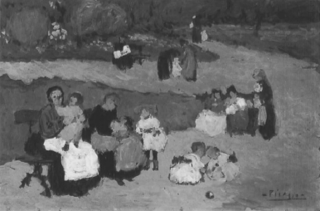
| |
| |
his choice of motifs. After a return to Spain, Picasso again went to Paris in May 1901, where he exhibited with Vollard, receiving a fine review in La Revue Blanche: ‘Like all pure painters, he adores colour for itself and each substance has its proper colour.’ In addition to the nightlife scenes, Picasso turned regularly to the everyday sights he observed in the streets and sunny parks of Paris: flower vendors, travellers on the omnibus, elegant ladies promenading in Auteuil. This scene of children playing in one of the capital's public parks fully conveys his interest in vivid colour. There is also a second version of this subject (present location unknown). This is the Van Gogh Museum's second loan of an early work by Picasso, whose Van Gogh-like ‘Still life with irises’ has also been on loan from a Dutch private collection since 1994.
Provenance Paul Pétridès, Paris; Paris (Galerie Charpentier), 1 December 1959; Mr and Mrs Silvan Kocher, Solothurn; private collection, the Netherlands; on loan to the Van Gogh Museum (1995).
Literature Exhib. cat. De Monet à Picasso, Geneva (Musée de l'Athénée) 1963, no. 4 (as ‘Le Jardin du Luxembourg’); Pierre Daix and Georges Boudaille, Picasso. The blue and rose periods: a catalogue raisonné of the paintings, 1900-1906, Greenwich, Conn. 1966, no. V. 19.
| |
Quost, Ernest
French, 1844-1931
Garden with hollyhock
Oil on panel, 42 × 54 cm
Signed at lower right: E. Quost; inscribed on the back: A Theo van Gogh/Ce tableau qu'aime tant mon ami Vincent/Bien amicalement/E. Quost
s 457 V/1996
Quost, who began his career decorating porcelain for the Sèvres factory, was primarily a flower painter. He studied at the Academy Julian in Paris, and found his subjects in rural Montmartre, where he had his own garden. Although he made his debut at the Salon des Refusés in 1863, his impressionistic style also brought him success on the official circuit. The state bought several of his works, and between 1880 and 1900 he won no fewer than five medals at mainstream exhibitions.
Vincent van Gogh, who probably met Quost for the first time in 1886, sung his praises as the painter of
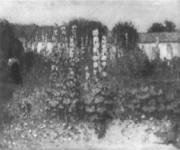
the ‘roses trémières’ [854/626], and set out to follow in his footsteps with his own still lifes. In 1890 both he and Theo were captivated by a work by Quost at the Salon, and Vincent came up with the idea of acquiring a sample of the artist's work. ‘I would like you to have a Quost, we can probably make an exchange’ [896/644]. After the Salon closed Theo wanted to display the painting in the window of the gallery he managed in Montmartre, alongside a flower piece by his brother.
It is not known whether the proposed exchange ever took place. The only work by Quost in the surviving collection of the Van Gogh family is a drawing. Recently, though, a painting by this French flower specialist did turn up with a provenance that definitely began with Theo van Gogh. ‘A Theo van Gogh Ce tableau qu'aime tant mon ami Vincent Bien amicalement E. Quost,’ is the inscription on the stretcher. The canvas is typical of Quost's work: a domestic garden with hollyhocks painted in soft pastel tones. It is tempting to identify this painting with the one that Theo and Vincent admired so much, but in fact there is no evidence that would support this. The work exhibited at the Salon appears to be of another subject. The catalogue lists it as Fleur de Pâques.
Provenance Theo van Gogh; Galerie Elstir, Paris; purchased by the Vincent van Gogh Foundation (1996).
| |
Sluijters, Jan
Dutch, 1881-1957
Paris at Whitsuntide 1906
Oil on canvas, 33.2 × 41 cm
Signed and dated at lower left: Jan Sluijters - 06; annotated at lower right: Pentecôte. Au Pont
s 449 V/1995
The literature on Sluijters made no mention of this work before its purchase in 1995. It dates from 1906, when the young artist was staying in Paris after winning the Prix de Rome. In 1987 the Van Gogh Museum bought another painting from this period, the shocking Two women embracing, which has Parisian nightlife as its theme.
This new acquisition shows Paris at its sunniest, bedecked
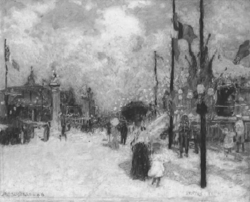
| |
| |
with festive tricolours and with promenaders on Pont Alexandre III, close to the Grand Palais, whose dome is visible at left. The inscription tells us that it is Pentacost 1906. Reporting from the capital on 26 June 1906, the artist wrote that he was working on ‘six studies for townscapes,’ including ‘a pair of studies for a fair at Pont Alexandre.’ This richly-decorated bridge had been built on the occasion of the 1900 Exposition Universelle. Two of the gilded bronze sculptures on their tall pillars are visible in Sluijters's painting.
The loose, colourful technique - the ubiquitous red! - betrays the careful attention Sluijters must have paid at the Salon des Indépendants, where work by Signac and by Fauves such as a Braque, Derain and Van Dongen had all been present in abundance.
Provenance Private collection; purchased by the Vincent van Gogh Foundation (1995).
Literature Van Gogh Bulletin 10 (1995), no. 2, p. 15.
| |
Ter Meulen, François Pieter
Dutch, 1843-1927
Sand wagons before 1893
Oil on canvas on panel, 56.5 × 98 cm
Signed at lower left: ter MEUlen
s 16 SM/1995
Ter Meulen was a pupil of both Hendrikus and Julius Jacobus van de Sande Bakhuyzen, and Vincent van Gogh remembered seeing him at work in the latter's studio. He became a disciple of Anton Mauve, whose example he followed when choosing to paint a horse-drawn sand wagon virtually parallel to the picture plane. He settled in The Hague in 1875, where he specialised mainly in scenes of livestock in dune and heath landscapes. His heyday came in 1886, when the newly-opened Rijksmuseum in Amsterdam bought his painting In the woods. The Museum Mesdag already owned a large watercolour of sheep by Ter Meulen. In 1899 Sand wagons was illustrated in Max Rooses's Schildersboek.
Provenance Private collection; donated to the Museum Mesdag (1995).
Literature F.P. ter Meulen, ‘Herinneringen,’ Elsevier's Geïllustreerd Maandschrift 5 (1892), pp. 557-74;
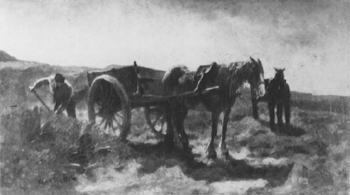
M. Roosen (ed.), Het schildersboek: Nederlandsche schilders der negentiende eeuw in monographieën door tijdgenooten, 4 vols., Amsterdam 1889-1901, vol. 2, p. 89.
| |
Valtat, Louis
French, 1869-1952
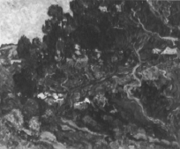
Red cliffs near Anthéor c. 1903
Oil on canvas, 81.5 × 99.2 cm
Signed at lower right: L. Valtat
s 447 V/1994 (colour pl. p. 191)
In the early 1890s Valtat developed a highly individual style derived from Impressionism, one marked by agitated brushwork and bright colours. Viewed superficially, his work resembles that of the Fauves, but he never abandoned the conventional Impressionist depiction of space for the sake of pure colour.
In 1889 Valtat had settled at Anthéor on the Côte d'Azur in a house called ‘Roucas Rou’ after the red rocks of the local coastline. Those cliffs feature prominently in many of his landscapes, as does a female figure. In a letter of 19 June 1995, Louis-André Valtat, the painter's grandson, confirmed to the museum that the model was probably Suzanne Noël, the artist's wife. A photograph of her in very much the same pose is still extant.
This painting of a rocky coast covered with pine trees must date from around 1903. It is modelled with vigorous, snaking brush strokes that appear to lead a life of their own - a feature no doubt influenced by Valtat's encounter with the work of Van Gogh. Valtat may have seen the Dutchman's work at the 1901 retrospective exhibition held at the Bernheim Jeune gallery. In addition, the dealer Ambroise Vollard, with whom Valtat had had a fixed contract since 1900, had more than two dozen Van Goghs in stock.
The first owner of the canvas was Christian Cherfils, who also owned two paintings by Van Gogh (F 319 and F 445).
Provenance Christian Cherfils; Laura Cherfils; private collection, New York; Marc de Montebello Fine Art, New York; purchased by the Vincent van Gogh Foundation (1994).
Literature Van Gogh Bulletin 10 (1995), no. 2, pp. 13-14.
| |
| |
| |
Drawings
Doré, Gustave
French, 1832-1883
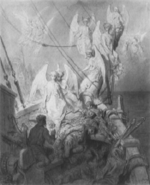
‘This seraph-band, each waved his hand: It was a heavenly sight!’
Design for a wood engraving to accompany Samuel Taylor Coleridge, The rime of the ancient mariner, London 1875
Pencil, pen in black ink, brown and grey wash, heightened with white, on wove paper, (sheet) 58.7 × 46.1 cm; (drawing [including outline]) 50.7 × 41.9 cm
Signed at lower right: G. Doré; red stamp at lower left: Atelier G. Doré; annotation at bottom centre: No 4
d 1043 S/1995
Although Doré produced nearly 10,000 illustrations, only a few hundred designs have survived. One of these is this virtuosic pen-and-ink drawing, a design for one of the wood engravings for The rime of the ancient mariner. The designs were transferred to the woodblocks by means of a photographic process and then engraved by a professional engraver. In Coleridge's seven-part poem, an elderly sailor recounts the fate that befell his ship after he had shot an albatross. Each of his fellow crew members perished. However, angelic spirits entered their bodies and guided the ship safely homeward. Once arrived, they left the bodies once more to stand above them. This is the moment, from the sixth part of the poem, that is illustrated here: ‘This seraph-band, each waved his hand/It was a heavenly sight!.’ As the annotation ‘No 4’ at lower centre possibly suggests, it was the fourth illustration to the sixth part.
The sheet may be one of the drawings incorporated in the sale catalogue for Doré's estate under lot 98: ‘Quatre dessins pour l'Ancient Mariner.’
Provenance L.A. Houthakker gallery, Amsterdam; purchased by the Van Gogh Museum (1995).
Literature Catalogue de la vente Doré (Avril 1885), included in Henri Leblanc, Catalogue de l'oeuvre complet de Gustave Doré, Paris 1931, p. 493.
| |
Dufy, Raoul
French, 1877-1953
Laundry boats on the Seine c. 1904
Watercolour and gouache on three horizontal strips of vergé paper on cardboard, 68.8 × 56.5 cm
Signed at lower right: Dufy
d 1045 S/1995 (colour pl. p. 190)
On various occasions in the early years of the century Raoul Dufy painted scenes featuring boats on the Seine in Paris; among them is this attractive large sheet, which is thought to date from 1904. The boats we look down upon are almost certainly bateaux-lavoirs, the laundry boats where well-to-do Parisians had their washing done.
The artist assembled this sheet with three horizontal strips of vergé paper. True to the spontaneous style of Dufy's early work, the whole has been executed rapidly and without preliminary drawing.
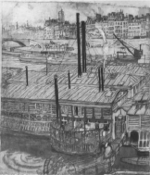
Provenance Marc de Montebello Fine Art, New York; Christopher Drake, London; purchased by the Van Gogh Museum (1995).
Literature Van Gogh Bulletin 11 (1996), no. 2, pp. 8-9.
| |
Houten, Barbara van
Dutch, 1862-1950
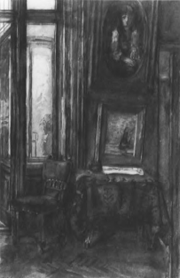
Living room corner c. 1886
Watercolour, 47 × 31 cm
Signed at lower right: B van Houten
d 22 SM/1996
After the death of his second wife, Samuel van Houten, Barbara's father, moved to the Riouwstraat in The Hague. Before this time, the Van Houtens had lived with the Mesdags in the grand house on the Laan van Meerdervoort the couples had built together in 1869. Following the move, Barbara began to take care of her father and was thus more or less bound to the house. The artist made a series of large-scale watercolours of her new domicile, some of which are in the Rijksprentenkabinet (Rijksmuseum) in Amsterdam. The Van Gogh Museum's work, as a comparison
| |
| |
with a photograph in Storm de Grave-Smit's book of 1991 on the artist demonstrates, depicts the corner of the spacious living room, with a glazed verandah in the background. Above the table hangs a seascape, probably a work of Barbara's uncle, H.W. Mesdag.
Provenance Gift of Kunsthandel R. Polak to the Van Gogh Museum, The Hague (1996).
Literature G. Knuttel, Jr, Barbara van Houten, Amsterdam 1948; Madi Storm de Grave-Smit, exhib. cat. Barbara van Houten, The Hague (Panorama Mesdag) 1991
| |
Mauve, Anton
Dutch, 1838-1888
Heath at Laren c. 1887
Watercolour, 52.5 × 81.5 cm
Signed at lower right: A. Mauve
d 1046 S/1996
Anton Mauve worked and lived in the Gooi from 1885 onwards, some years after Jozef Israëls had drawn his attention to the beauty of this area, which lies to the east of Amsterdam. When urban pressure began to make The Hague less attractive to painters, the region around the small town of Laren became a kind of promised land to Mauve and others.
In terms both of theme and of composition, this monumental watercolour is almost identical to the well-known painting from the Drucker-Fraser Bequest in the Rijksmuseum. It cannot be established with any certainty whether the watercolour precedes or duplicates this 1887 work. In 1886 Mauve exhibited a drawing with the same subject at the Hollandsche Teeken-Maatschappij; it may well have been this work. Its expressiveness derives from the contrast between the ‘woolly’ foreground with the sheep and the monumental group of trees outlined against the horizon, a motif strongly reminiscent of Millet.
Provenance Private collection, USA; Kunsthandel R. Polak, The Hague; purchased by the Van Gogh Museum (1996).
Literature Ronald de Leeuw et al., exhib. cat. The Hague School: Dutch masters of the 19th century,
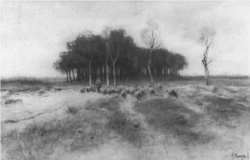
Paris (Grand Palais), London (The Royal Academy) & The Hague (Gemeentemuseum) 1983, p. 255 (with extensive literature).
| |
Raffaëlli, Jean-François
French, 1850-1924
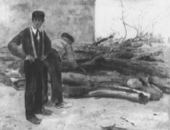
Woodcutters at the end of the day c. 1880
Pencil, black chalk, pastel and oils on cardboard, marouflé on panel, 56.9 × 75.3 cm
Signed in pen at lower left J.F. Raffaëlli
d 1041 S/1995 (colour pl. p. 188)
Raffaëlli showed this drawing at the Exposition Universelle in 1889. It is in a variety of media and was then entitled Hommes venant de couper des arbres. And indeed, the men have just finished their job; the rearmost figure is laying the last trunk on a pile of timber. Raffaëlli depicted a great variety of occupations, frequently choosing - as here - a moment when the exponent could be seen at rest. The men acting as models for him in this painting feature in different roles in other works.
Raffaëlli experimented eagerly with a number of techniques, and in his drawings he often sought to express painterly qualities, as this work shows. He himself developed the oily pastel which was used here. The brush strokes that can be seen in some places were no doubt intended to enliven the scene.
Provenance Mr Blumenthal; Antonio Santamarina; sale Adolfo Bullrich & Cia collection, lot 70; Galerie Andreas Watteau, Paris; London (Christie's), 5 July 1968, lot 40; Hammer Gallery, New York; New York (Christie's), 15 February 1995, lot 56; purchased by the Van Gogh Museum (1995).
Literature Exhib. cat. Exposition universelle internationale de 1889 à Paris, Paris 1889, no. 564; Barbara Schinman Fields, Jean-François Raffaëlli (1850-1924): the naturalist artist, Ann Arbor, Mich. 1979, pp. 192-93, 358, fig. 54.
| |
Redon, Odilon
French, 1840-1916
Drawing ‘à la Goya’ (At the window) 1878
Charcoal on light brown paper, 39.3 × 32.7 cm
Signed at lower right: Odilon Redon
d 1048 V/1996 (colour pl. p. 187)
Windows and doorways, sometimes barred, are an important leitmotif in the art of Odilon Redon; in
| |
| |
the noirs of the 1890s they play an especially prominent role. It is not hard to understand why the artist entitled this sombre drawing ‘à la Goya.’ The man it depicts also bears a certain resemblance to Des Esseintes, the decadent hero of Joris-Karl Huysmans's book, A rebours. In Andries Bonger's collection the work was known as Chevalier à la fenêtre. It is in the context of this drawing that Druick and Zegers speak of ‘existential imprisonment’ and ‘psychological alienation,’ seeing the figure in the window as ‘an outsider.’
This charcoal drawing belonged to Andries Bonger (1861-1936), Theo van Gogh's brother-in-law, from whose collection the museum has been able to acquire a number of works in recent years; these include three fine pastels and two noirs by Redon. The drawing has an attractive wooden frame, which, to surmise from the label of a Brussels firm, was probably chosen by its first owner, the Belgian writer Edmond Picard. At the auction of Picard's estate, Bonger also bought the noir entitled Yseult, and possibly Girl's head in left profile, with flowers.
Provenance Sale Picard collection, Brussels, 26 March 1904, lot 94; A. Bonger (1904-36); F.W.M. Bonger-Baroness van der Borch van Verwolde, Almen; private collection; purchased by the Vincent van Gogh Foundation (1996).
Literature Exhib. cat. Peintures, dessins et lithographies par Odilon Redon, Rotterdam (Kunstzaal Reckers), no. 1907, no. 35; exhib. cat. André Bonger en zijn kunstenaarsvrienden, Amsterdam (Rijksmuseum) 1972, no. 40; exhib. cat. Redon Chicago (The Art Institute), Amsterdam (Van Gogh Museum) & London (Royal Academy) 1994-95, p. 146, fig. 35.
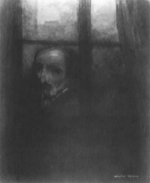

The source c. 1880-81
Charcoal on tinted paper, 47.5 × 36.5 cm
Signed at lower left: Odilon REDON
d 1044 S/1995 (colour pl. p. 186)
To Redon, centuries-old trees had a special significance. Visiting The Hague in 1878, he wrote enthusiastically about the woodland known as the Haagse Bos: ‘There is [here] a relic of a druid wood that leaves one with a sense of nostalgia.’ This yearning for the distant past, to which these forest giants bore witness, was also a yen for his own childhood and for the family estate near Bordeaux, where he had spent nearly every summer.
The theme of this noir is not entirely clear, which may explain the variety of titles by which it was known: La Source, Intérieur d'un bois, Deux druïdes près d'un étang, etc. A naked man sits on the riverbank with something resembling a beaker in his hand, while the standing figure, classically draped, appears to be instructing him. The drawing seems to allude to the opposition between good and evil, the enlightened and the primitive, white and black. These are all central themes in Redon's noirs, as we can also see in his 1877 drawing Angel and demon (Bordeaux, Musées des Beaux-Arts). The Van Gogh Museum work dates from around 1880.
Andries Bonger obtained most of his collection of Redon works directly from the artist, but in this case the purchase was made in about 1930 from the Haarlem dealer De Bois.
Provenance J.H. de Bois, Haarlem (1913-30); A. Bonger (to 1936); F.W.M. Bonger-Baroness van der Borch van Verwolde, Almen; private collection, The Netherlands; purchased by the Van Gogh Museum (1995).
Literature Svend Sandström, Le monde imaginaire d'Odilon Redon, Lund 1955, pp. 10-11, 14 (fig. 9); Rosaline Bacou, Odilon Redon, 2 vols., Geneva 1956, vol. 1, pp. 41-46; exhib. cat. Odilon Redon, Paris (Orangerie des Tuileries) 1956, no. 8; exhib. cat. Odilon Redon, The Hague (Gemeentemuseum) 1957, no. 2; exhib. cat. Odilon Redon, 1840-1916, Bern (Kunsthalle) 1958, no. 15; Klaus Berger, Odilon Redon: Phantasie und Farbe, Cologne 1964, no. 560; exhib. cat. Franse tekeningen van Claude tot Cézanne, Paris (Institut Néerlandais) & Amsterdam (Rijksmuseum) 1964, no. 189; exhib. cat. André Bonger en zijn kunstenaarsvrienden, Amsterdam (Rijksmuseum) 1972, no. 36; exhib. cat. Odilon Redon 1840-1916: tekeningen, litho's, pastels en schilderijen uit Nederlands bezit, Enschede (Rijksmuseum Twenthe) 1984, no. 2; J.F. Heijbroek and E.L. Wouthuysen, Kunst, kennis en commercie: De kunsthandelaar J.H. de Bois, 1878-1946, Amsterdam 1993, p. 218 (also further literature for the period 1913-1929); Odilon Redon, Confidenties van een kunstenaar, trans. and intro. Fred Leeman, Amsterdam 1994; Van Gogh Bulletin 11 (1996), no. 2, p. 14; Gazette des Beaux-Arts 138 (March 1996), p. 94.
| |
Tissot, James (Jacques-Joseph)
French, 1836-1902
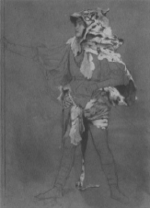
Study for ‘The triumph of will: the challenge’ c. 1877
Brush drawing in grey, with flesh colour over black chalk on blue paper, 54.7 × 39.9 cm
Signed at lower right: James Tissot
d 1042 S/1995 (colour pl. p. 178)
| |
| |
In this so-called drapery study, all the artist's attention has been directed towards the depiction of the tigerskin, which is executed in colour, and the way in which it falls about the slender body of the boy, which is shown only in outline and grey. The boy's face is the only other element to be depicted in detail. There are clear signs that the study was painted straight over an earlier study of a female figure, which has been insufficiently erased.
A tigerskin is also featured in the painting Le petit Nemrod, which dates from around 1882 (Besançon, Musée des Beaux-Arts et d'Archéologie), a work with which this attractive drawing was therefore initially thought to be connected. (The subject of that particular painting is children playing in an autumnal park; children were repeatedly the subject of Tissot's work in this period.) It later came to light that our study was of an earlier date, and was associated with Tissot's short-lived 1877 project to create an allegorical series entitled The triumph of will. The boy with the tigerskin appears in the only section to be completed, The challenge; he represents the figure of Daring. The canvas shows how Will, a fair woman with sword and armour, who is also assisted by Daring and Reserve, strides over Vice. A scutcheon bears the motto ‘Audere, volle, tacere.’ The drawing was shown in 1877 at an exhibition in London's Grosvenor Gallery, where it was praised by no lesser personage than John Ruskin.
Although Tissot's reputation rests largely upon his depictions of sophisticated and fashionably-dressed women, the artist also painted a number of didactic and allegorical series. One of these, his four-part Prodigal son in modern life, won a gold medal at the 1889 Exposition Universelle.
Provenance P. and D. Colnaghi and Co. Ltd, London (1970); Mr and Mrs Eliot Hodgkin; London (Christie's) 26 October 1982, lot 75; Christopher Wood Gallery, London; purchased by the Van Gogh Museum (1995).
Literature Michael Wentworth, James Tissot: catalogue raisonné of his prints, Minneapolis 1978, pp. 330, 333, and fig. 83a; exhib. cat. James Tissot, London (Barbican Art Gallery) 1984, additional entry p. 141 (with ill.)

| |
Toorop, Jan Theodorus
Dutch, 1858-1927
Cor Cordium 1890-91
Black chalk and pencil on wove paper on cardboard, (sheet) 58.2 × 53.0 cm; (cardboard) 58.2 × 56.7; (drawing) 58.2 × 54.8 cm (at left, a diagonal strip, 1.8 cm at its widest point, has been drawn onto the cardboard)
With notes and annotations in pencil at lower right: naar de ‘COR CORDIUM’ van / Alb. Verwey / J Th Toorop
d 135 B/1996
Toorop regularly turned to literature for the inspiration for his designs. The drawing Cor Cordium (‘heart of all hearts’) owes its genesis to a poem of the same name by Albert Verwey (published in Nieuwe Gids 1/2 [1886], pp. 469-77):
‘Woe is me! Seated in my house, I heard / Thoughts voicing once more within me, / Coming slowly from afar, like the rush / Of wind between the houses: / But strange it was, this sound; as one might hear / When travelling from northern regions to the south / Amongst other peoples; might hearken word by word. / To deaf walkers speaking in a foreign street / In southern tongues: - and I saw, and see! / Deep in the dusk of my soul / A throng of figures move, such as at times / I saw. / Crossing the bridges as I left my house, / Walking the canals where the mist stole / Of a November morning: the wind lay / Irresolute above the town: so it was in me.’
The throng of figures can be clearly discerned in the foreground, and do indeed appear to be crossing a bridge. Other elements, however, seem to have sprung rather from Toorop's imagination than from the poem. A Japanese woman's head, probably derived from a Japanese woodcut, can be seen in the upper half of the picture, between the female figures that loom like a dark mist from between the houses in a street. The drawing was first owned by the Dutch poet Albert Verwey, in whose family it remained until acquired by its present owners
Provenance Albert Verwey, Noorwijk aan Zee; Mrs Dr M. Nijland-Verwey, Santpoort; heirs of Dr M. Nijland-Verwey; private collection, Utrecht; on loan to the Van Gogh Museum (1996).
Literature A. Plasschaert, Jan Toorop, Amsterdam 1925, no. 1890-8; Bettina Polak, Het fin-de-siècle in de Nederlandse schilderkunst: De symbolistische beweging 1890-1900, The Hague 1955, pp. 97-98, no. 16, fig. 8; Mea Nijland-Verwey, Kunstenaarslevens: De briefwisseling van Albert Verwey met Alphons Diepenbrock, Herman Gorter, R.N. Roland Holst, Henriette van der Schalk en J.Th. Toorop, Assen 1959, fig. opposite p. 65; R. Siebelhoff, The early development of Jan Toorop 1879-1892, (diss., Toronto, University of Toronto, 1973), pp. 134, 281-82; R. de Leeuw, exhib. cat. Haagse Kunstkring: Werk verzameld, The Hague (Gemeentemuseum) 1977, p. 15, fig. 20; C. Blotkamp and M. Rijnders, exhib. cat. Kunstenaren der idee: Symbolistische tendenzen in Nederland, ca. 1880-1930, The Hague (Gemeentemuseum) 1978, pp. 80-81, fig. 48; Rein van der Wiel, Ewijkshoeve, tuin van tachtig, Amsterdam 1988,
|
|